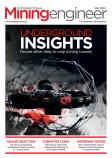The Underground Mining group within Caterpillar has shipped a proof of concept battery electric LHD to a mine site located in Canada. The initial build and validation testing of this R1300G test unit began in early 2017 at the Caterpillar Peoria Proving Grounds and continues now, moving muck in the mine.
The test machine is a proof of concept for packaging and performance of a lithium-based energy storage solution Caterpillar plans to bring to the LHD market. The Cat R1300G does not represent a final design that will go to market. After testing, Caterpillar will launch a full-fledged new product introduction program that follows a more in-depth, rigorous design and validation process.
“Our customers are planning for deeper mines with very high ambient rock temperatures where ventilation costs are pivotal to making the mine viable,” said Jay Armburger, product manager with responsibility for underground technology. “One means of reducing ventilation demand is through electrification of the mining equipment.”
With over 250 patents in the electric drive and energy storage fields, and products like the D7E dozer, F-Series asphalt pavers, 794 AC and 795F AC large mining trucks, the recently introduced 988K XE wheel loader, and even microgrid technology, Caterpillar has fully integrated electric drive train technology and components to bring to underground machines.
Setting high performance standards
The program started with a full production study and data analysis of the diesel machine in order to set a baseline. Once this was accomplished, the transformation of the R1300G to a battery electric proof of concept began. The modifications included removing the engine, transmission and torque converter then reconfiguring the engine end frame to accommodate the battery boxes and electric motors. The result is a battery electric powertrain driving a conventional and mechanical drivetrain (drive shafts and axles).
The R1300G proof of concept is an older machine without the benefit of efficient electro-hydraulics. As a result, it will drive worst case scenario loads on the batteries. Of course, the design of the new loader will enhance battery life through the use of load sensing hydraulics driven by piston pumps such as those on the new Cat R1700. The less refined proof of concept machine will yield solid understanding of heat generation and cooling needs, performance criteria, space claim and safety considerations in the day-to-day operation of the machine.





















